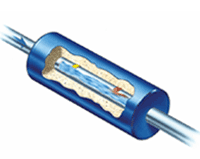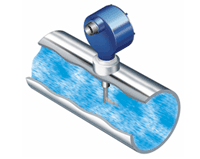

- Low Flow Liquid Meters
- Low Flow Gas Meters
- Duct Flow Meters for Air & Gas
- Low Flow Controller
- MaxExtractor Extraction Monitor
- Multi-Variable Process Meter
- Bidirectional Flow Meters
- RheoVac® Multisensor Flow Monitors
- Custom Process Measurement
- Flow Switches
- Instruments for Hazardous Locations
- Electronics Options
Flow Switches
Rheotherm flow switches provide reliable switch protection in all  types of liquid or gas service. From critical monitoring of extremely low flow process additives to loss of flow protection in large water or air lines, we can handle most flow switch applications. With no moving parts in these devices, their long-term reliability is assured. Options for hazardous sites (explosion-proof, intrinsically safe) are available as well. These devices, like all Rheotherm flow instruments, are protected by an ISO-9001:2015 certified Quality Assurance program.
types of liquid or gas service. From critical monitoring of extremely low flow process additives to loss of flow protection in large water or air lines, we can handle most flow switch applications. With no moving parts in these devices, their long-term reliability is assured. Options for hazardous sites (explosion-proof, intrinsically safe) are available as well. These devices, like all Rheotherm flow instruments, are protected by an ISO-9001:2015 certified Quality Assurance program.
Overview of Flow Switches
Flow switches play an important role in regulating the flow rate of fluids through a system. They perform this function by sending a trip signal to another system element (often a pump) that responds by modifying the fluid flow rate as needed. Flow switches are also used for indication of certain process conditions such as flow/no-flow to alert operating personnel by connecting them to indicator lights or audible alarms.
Every flow switch has a set point, which is a maximum or minimum flow rate. The set point is typically user-adjustable. When the flow of media reaches the existing set point, the switch prompts the pump (or other mechanism) to turn on or off. The switch can be set to trigger in either low-to-high (e.g., trigger when flow goes from 0 to any flow) or high-to-low (e.g., trigger when flow goes to 0 from any flow value) to match the process requirements. This sequence of events results in the increase or decrease of the flow rate, depending on the requirements of the application.
What Kind of Service Can Our Flow Switches Provide?
You name it—all types of liquids and gases, big pipes or small lines, hot or cold. Here is a partial listing of the types of fluids that Rheotherm in-line flow switches have been used to monitor:
- Ammonia
- Antifoam
- Argon
- Butane
- Carbon Dioxide
- Carbon Monoxide
- Chlorine
- Coal Gas
- Coke Gas
- Diesel Exhaust
- Digester Gas
- Ethane
- Ethanol
- Ethylene
- Ferric Chloride
- Flare Gas
- Flue Gas
- Fluorine Gas
- Fuel
- Helium
- Hydrocarbon Gas
- Hydrofluorosilicic Acid
- Liquid Chlorine
- Methane
- Natural Gas
- Oxygen
- Propane Vapor
- Propylene
- Sulfur Dioxide
- Tungsten Hexafluoride
As one of the leading thermal flow switch manufacturers active today, we’re proud to note that these state-of-the-art devices have been used successfully in thousands of installations. The Applications section of the website includes a complete list of the various fluids where our flow switches have been used.
Rheotherm Flow Switches can be found in a broad range of applications, from HVAC systems to water treatment facilities. Some of the industries that currently use our air, liquid, and gas flow switches include:
- Aerospace
- Chemical and Petrochemical
- Natural Gas
- Oil and Gas Production
- Wastewater Treatment
- Pulp and Paper
The Industries section has more information on the industries and applications where our low flow switches have been used. Contact us with any questions about your specific application.
How Are They Installed?
 Our in-line flow switches for monitoring flows in small lines are usually installed with standard tube fittings, but are optionally available with flanges, NPT, sanitary fittings, etc. Insertion probe flow switches for monitoring large (1” or larger) pipe flows are typically installed with 1” NPT or flange fittings. They can be used in vertical or horizontal lines. For most common applications, the sensor and electronics form an integral unit.
Our in-line flow switches for monitoring flows in small lines are usually installed with standard tube fittings, but are optionally available with flanges, NPT, sanitary fittings, etc. Insertion probe flow switches for monitoring large (1” or larger) pipe flows are typically installed with 1” NPT or flange fittings. They can be used in vertical or horizontal lines. For most common applications, the sensor and electronics form an integral unit.
How Do They Work?
Rheotherm flow switches and monitors come with highly advanced thermal flow-sensing technology to ensure optimal performance. Our in-line flow sensors use a straight-through flow tube with a heated and an unheated RTD (Resistance Temperature Detector) attached to the outside of the tube. The insertion probe flow sensors include one tip with a heated RTD and another tip with an unheated RTD. With both sensor styles, the temperature differential between these two RTDs produces the primary flow signal. At high flow rates, flow removes more heat, resulting in a lower differential. At low flow rates, the flow removes less heat, so the differential is higher.
With our inline industrial flow sensors, nothing touches the fluid but the metal sensor wall, and there are no mechanical parts that are susceptible to wearing, sticking, or breaking. We use unstressed components to enable years of low-maintenance operation. The sensor will not be damaged when the process flow stops or when the line empties.
Trip points are field adjustable, so you are always able to adapt quickly to changes in system conditions. Trip response times generally range from 2 to 25 seconds and can optionally be extended with a time delay. Our flow switches can operate in environments in the range of 0–120°F (-18–50°C); optional customizations can extend this range to -20–400°F (-29–200°C). Standard wetted parts are Grade 316 stainless steel, with other materials optionally available. More on Method of Operation (PDF)

Inline Sensor |

Insertion Sensor |
What Models Are Available?
We currently offer the following flow switch models:
Model 100CS – Lowest cost industrial option. Integral sensor/electronics with one SPDT relay, which is rated 10 A @ 120 Vac or 5 A @ 24Vdc. CE mark is available. Can be ordered with in-line or insertion probe sensor.
Model 100FS – Separate sensor and electronics with one SPDT relay. Option for second relay for high and low set points. Can be ordered with in-line or insertion probe sensor. This model is also available with an intrinsically isolated sensor for use in hazardous locations. Refer to the Instruments for Hazardous Locations page for more information.
Model 400 – Integral insertion probe sensor and electronics; has two SPDT relays or single relay w/ non-linear analog flow output signal. Calibrated signal optional.

Model 500 – In-line design with your choice of 1/16” O.D. or 1/8” O.D. flow tube connection options. Low flow switch for certain general-purpose applications; 24 VDC input power only.
Please contact us if you’re uncertain about which model would work best in your application.
How Do I Get One?
Contact one of our flow application specialists using the form on this page to configure a Rheotherm Flow Switch tailored to your application, flow switches RFQ. You can also download and complete the Flow Application Data Sheet and email it to us at sales-flow@bionetics.com.
For other questions and ways to reach us, visit our Contact Us page for telephone, fax and email information.
- No moving parts
- Exclusive inline TU sensor
- Advanced signal processing electronics
- Field adjustable switch point
- Maintenance-free
- Easy installation
- Choice of wetted materials
- Long-term reliability
| Standard | Options | |
| Temperature | Process: 0 – 140°F (-18 – 60°C) Environment: 0 – 120°F (-18 – 50°C) |
Inline: -20 – 350°F (-30 – 175°C) Probe: -20 – 400 °F (-30 – 200 °C) |
| Pressure | 0 – 1,000 PSI | Up to 30,000 PSI |
| Calibration Accuracy | ± 1% of reading typical | |
| Response Time | 1 sec. ; 3 – 5 sec. typ. (63% of range); |
Time constant/delay option |
| Repeatability | ± 0.5% of reading | |
| Standard | Options | |
| Line Sizes | Inline sensor (flow range dependent): – Capillary; – 1/16”; 1/8”; 3/16”; 1/4” – 3/8”; 1/2”; 5/8”; 3/4”; 1” Probe sensor: Pipe/Duct from 1.5” – 72” (round, square, rectangular) |
Other sizes via fittings/adapters |
| Process Connection | Inline sensor: Plain tube stubs suitable for compression fittings Probe sensor: 1″ MNPT |
– MNPT; – Tri-Clover (Sanitary); – SS Flange (1/2” – 2”); Most other fittings available |
| Wetted Material | 316 SS | – Hastelloy C-276®; – Monel®; – Alloy 20; – Titanium; – Tantalum; – Inconel |
| Standard | Options | |
| Enclosure | Sensor: – Inline – PVC – Probe – NEMA 4X (junction box) Electronics: – Integrated – NEMA 4X Cast Aluminum – Remote – NEMA 4 |
Inline sensor: Stainless steel Remote electronics: – Stainless steel – NEMA 7 Explosion-proof |
| Hazardous Environment | Remote electronics with 100FS only FM Approved for: – Class I, Div. 1, Groups A,B,C,D – Class I, Zone 1, IIB+H2 (US) – Class II, Div. 1, Groups E, F, G – Class III, Div. 1 |
|
| Outputs | Single SPDT Form C relay (10A, 125 VAC) |
Remote electronics with 100FS only – Second independent SPDT relay – DPDT relay – Time delay on switch |
| Input Power | 110/230 VAC ±10V | 24 VDC ±4V (200 mA) |
Inline Sensor Flow Capacities for Liquids
| TUBE SIZE | ||||||||||
| FLOW RATE LIMITS | C | 1/16 | 1/8 | 3/16 | 1/4 | 3/8 | 1/2 | 5/8* | 3/4* | 1* |
| Extended Maximum | 2 | 60 | 500 | 0.4 | 1 | 2.5 | 4.6 | 8 | 10 | 20 |
| Normal Maximum | 1 | 30 | 250 | 0.25 | 0.5 | 1 | 2 | 3.5 | 4.5 | 8 |
| Normal Minimum | 0.03 | 0.8 | 6 | 0.008 | 0.01 | 0.03 | 0.05 | 0.2 | 0.3 | 0.5 |
| Extended Minimum | 0.007 | 0.05 | 3 | 0.002 | 0.006 | 0.01 | 0.02 | 0.07 | 0.1 | 0.2 |
| cc/min | GPM | |||||||||
*Limited applications. Consult Factory
Inline Sensor Flow Capacities for Gases
| TUBE SIZE | ||||||||||
| FLOW RATE LIMITS | C | 1/16 | 1/8 | 3/16 | 1/4 | 3/8 | 1/2 | 5/8 | 3/4 | 1 |
| Extended Maximum | 0.027 | 1.25 | 5 | 11 | 20 | 45 | 80 | 125 | 180 | 320 |
| Normal Maximum | 0.017 | 0.75 | 3 | 7 | 15 | 34 | 70 | 109 | 160 | 280 |
| Normal Minimum | 0.0017 | 0.02 | 0.1 | 0.2 | 0.4 | 0.9 | 1.6 | 2.5 | 3.6 | 6.4 |
| Extended Minimum | 0.0009 | 0.0017 | 0.05 | 0.1 | 0.2 | 0.5 | 0.8 | 1.2 | 2 | 3.2 |
| SCFM | ||||||||||
| 1 |
| 2 |
Probe-type Sensor Flow Capacities for Gases
| NPT/2I | ||
| VELOCITY LIMITS (ft/min) | Liquid* | Gas |
| Maximum | 150 | 25,000 |
| Minimum | 0.5 | 25 |
*Liquid Applications limited to Flow Switches only



